Before Wall Street’s opening bell Tuesday, the Bank of America released its Bull & Bear Index (B&B) on investor sentiment, signaling a new round of low expectations on the economy’s performance including predictions regarding inflation and recession.
The early Covid month of March 2020 was the last time investors ticked off underwhelming forecasts in the B&B which saw the Dow Jones record its top three intraday losses of all time since its doors opened in 1896.
The bearish signal comes out during a remarkably unstable economic moment fueled by global uncertainties surrounding predominant headlines on Russia, Europe and the U.S.
In the U.S., market analysts and American consumers grow increasingly speculative over the nation’s economic trajectory for the coming months. The two groups differ in reacting to unsettling headlines as investors hedge market uncertainty with ‘risk-on’ forecasts for profits, while consumers often suit their stereotype of saving cash (money under the mattress).
Interestingly, however, the symptoms of higher living costs like gas, food and health prices for American consumers share their origin with the same phenomena keeping investors up at night — growing inflation.
Understanding inflation
Inflation is measured in two separate fashions: the Consumer Price Index (CPI), reported by the Bureau of Labor Statistics, and the Personal Consumption Expenditures price index, reported by the Bureau of Economic Analysis.
The CPI ticker by the BLS is generally referenced more than its counterpart’s broader view of the economy’s price fluctuations.
It isn’t a fluke that Wall Street’s market skepticism comes only a few days after U.S. CPI figures drew global attention on July 13. The CPI’s 12-month view of the economy reported that consumer good prices have increased across the board, superseding many expectations, according to University of Florida economist Eugenio Rojas.
The BLS data reports a seasonally unadjusted inflation rate of 9.1%, the greatest 12-month increase since November 1981.
As it breaks a 40-year inflation, the index has done more to threaten America’s credibility in national economic leadership than suppress future concerns of sustaining families and growth after coming off a global pandemic.
The CPI inflation rate is best understood by its parts: seasonally unadjusted economic inputs like food and energy, which are averaged to show how much more American consumers are paying for goods during a specific time period, compared to the past.
Not only does inflation affect consumer purchasing power, but it has been seen as an inhibitor of recession. In other words, June’s inflation increase caught Americans by surprise, representing an inequality in how Americans have been consuming, investing and working versus the more likely reality indicated by increasing inflation: recession.
Under its umbrella of economic decline, recession has had varying indicators and consequences for countries around the world. However, inflation has become a primary target for the U.S. government as recession uncertainties still linger.
According to Rojas, inflation speculation has caused an “appreciating U.S. dollar and recession talks to replace positive economic outlooks,” as investors begin pricing in their pre-recession speculations in the capital markets, including the benchmark Euro-to-U.S. foreign exchange market.
For the first time in 20 years, the EUR/USD foreign exchange recently indicated the uncommon currency value of one-for-one.
The currency equality was priced in as the European Union finds itself increasingly insecure with their imported Russian natural gas, which accounts for almost 38% of all EU energy consumption.
Strikingly, however, the EU’s war against Russia’s expansion into neighboring Ukraine is just the surface of the EU’s current economic instability. As a consequence of, say, rising U.S. interest rates, investors secure themselves from countries incentivizing investment with low rates and have historically shifted toward U.S. Treasury bonds with higher yields.
Interestingly, in addition to its forecast, the U.S. Federal Reserve hasn’t raised rates by current margins in nearly 30 years. Further, the central bank’s strategy, Rojas insists, is falling behind precedence from this month’s unexpected figures.
Until now, the Fed’s monetary policy has been to increase rates by 75 basis points in July, which would make it the second straight month this raise has been utilized. According to Rojas, the issue with higher U.S. interest rates is the weight it bears on international markets. He explains that “as things begin to heat up, rates could increase more than we’d like them to,” which can already be seen through tightened labor markets and inflated posted salaries.
The University of Michigan’s Surveys of Consumers Index, which tracks consumer sentiment toward economic conditions, has found evidence of decade-long lows. In agreement with the survey, Rojas finds the validity of consumer sentiment as a disposable indicator of future economic performance credible because its objective represents a glimpse of behavioral trends American consumers will likely replicate if inflation continues to force consumers to save more and spend less in the general economy.
Though the leading 41.6% energy price hikes are snowballing inflation forward, with food prices following at 10.4%, the month of June saw lower national per gallon prices, as pre-Covid era supply chains have yet to realize current demand.
With President Joe Biden’s visit to Saudi Arabia in mid-July, many are hoping the additional oil supply from the OPEC member will alleviate U.S. gas perils with the effect of lowering the price at the pump. This is in light of the 30 cent decrease in the national price for regular gas this month, with Florida reporting a $4.00 gallon average for regular gas and Alachua County slightly over at $4.08.
But do these indicators mean we are heading towards recession?
According to a 1974 New York Times article by Julius Shiskin, two pre-existing conditions occur before recessions: two consecutive economic quarters of declining GDP and jobs losses.
Since the article’s publication, two recognized recessions took place in 1999 and 2008. However, Shiskin’s projections didn’t hold with 2001’s GDP estimates. What did prove true was the analyst’s second rule of thumb for recessions — low or declining jobs.
According to BLS unemployment data, the 2000’s recession both noticed unemployment ticks throughout the year before the official recession time frames designated by the National Bureau of Economic Research (NBER) happened.
The same phenomenon could be seen in July 2021’s high COVID unemployment rate that saw many Americans in hospitality, government and business services take sizable job losses. Unemployment peaked at 5.4%.
However, the national unemployment average has remained relatively consistent at a low 3.6% rate since March of this year.
What has shown substantial decreases in the past few months are real GDP numbers that Shiskin warned about, stifled during Q1, which are seemingly on track to decline as consumers begin to react to June’s inflation scare. Q2 has yet to be officially reported.
Is Florida representative of the national trend?
Not at the moment.
According to the latest Bureau of Workforce Statistics and Economic Research, employment figures for Florida unemployment have continuously decreased from 3.8% since April through June’s most recent 2.8% projection.
With much of the world depending on U.S. economic developments, the coming months will bring much needed data to tie recession expectations with historical trends.
Rojas disclaims that as we find ourselves with much more uncertainty for the future, a certain truth is that the U.S. will receive more international investment as foreign investors secure their finances in American banks.
Check out other recent articles from the Florida Political Review here.
Featured image: 3D Recovery and Recession. (Unmodified photo by Chris Potter used under a Creative Commons license (https://www.ccpixs.com/)





